Abstract
1. Measurements of brain and central blood temperature (Tbr and Tbl), metabolic rate (MR) and respiratory evaporative heat loss (REHL) were made in trained goats walking on a treadmill at 4.8 km h-1 at treadmill inclines of 0, 5, 10, 15 and 20% when they were fully hydrated and at 0% when they had been deprived of water for 72 h. 2. In hydrated goats, exercise MR increased progressively with increasing treadmill incline. Both Tbl and Tbr rose during exercise, but Tbl always rose more than Tbr, and selective brain cooling (SBC = Tbl - Tbr) increased linearly with Tbl. Significant linear relationships were also present between REHL and Tbl and between SBC and REHL. Neither the slope of the regression relating SBC to Tbl nor the threshold Tbl for onset of SBC was affected by exercise intensity. Manual occlusion of the angularis oculi veins decreased SBC in a walking goat, while occlusion of the facial veins increased SBC. 3. Dehydrated goats had higher levels of Tbl, Tbr and SBC during exercise, but the relationship between SBC and Tbl was the same in hydrated and dehydrated animals. In dehydrated animals, REHL at a given Tbl was lower and SBC was thus maintained at reduced rates of REHL. 4. It is concluded that SBC is a linear function of body core temperature in exercising goats and REHL appears to be a major factor underlying SBC in exercise. The maintenance of SBC in spite of reduced REHL in dehydrated animals could be a consequence of increased vascular resistance in the facial vein and increased flow of cool nasal venous blood into the cranial cavity.
Full text
PDF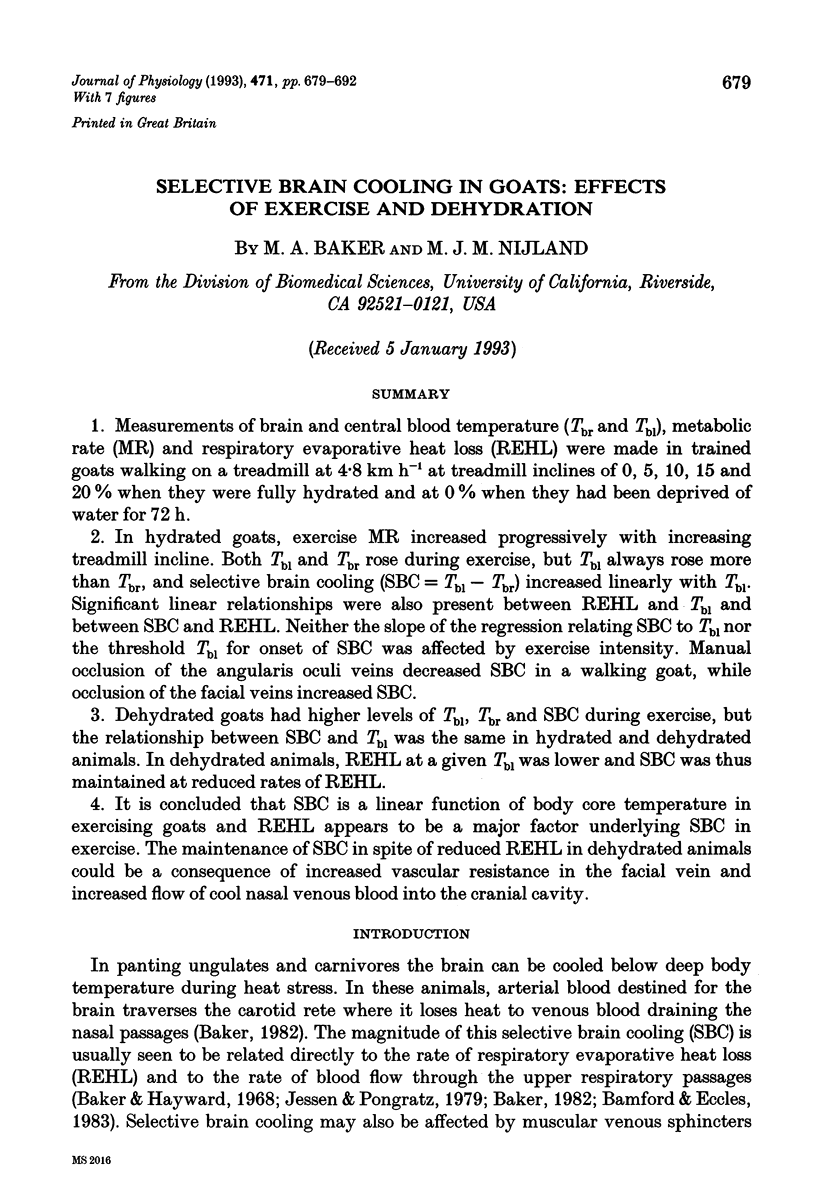
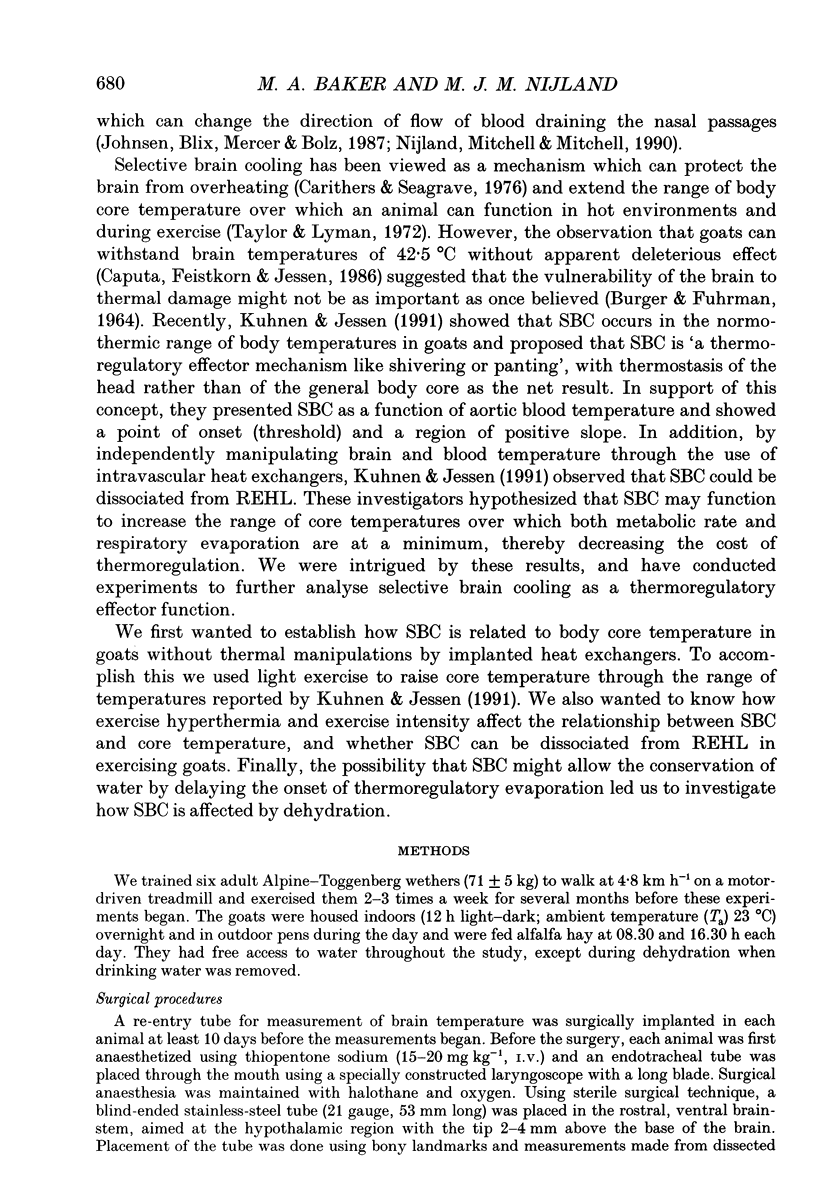
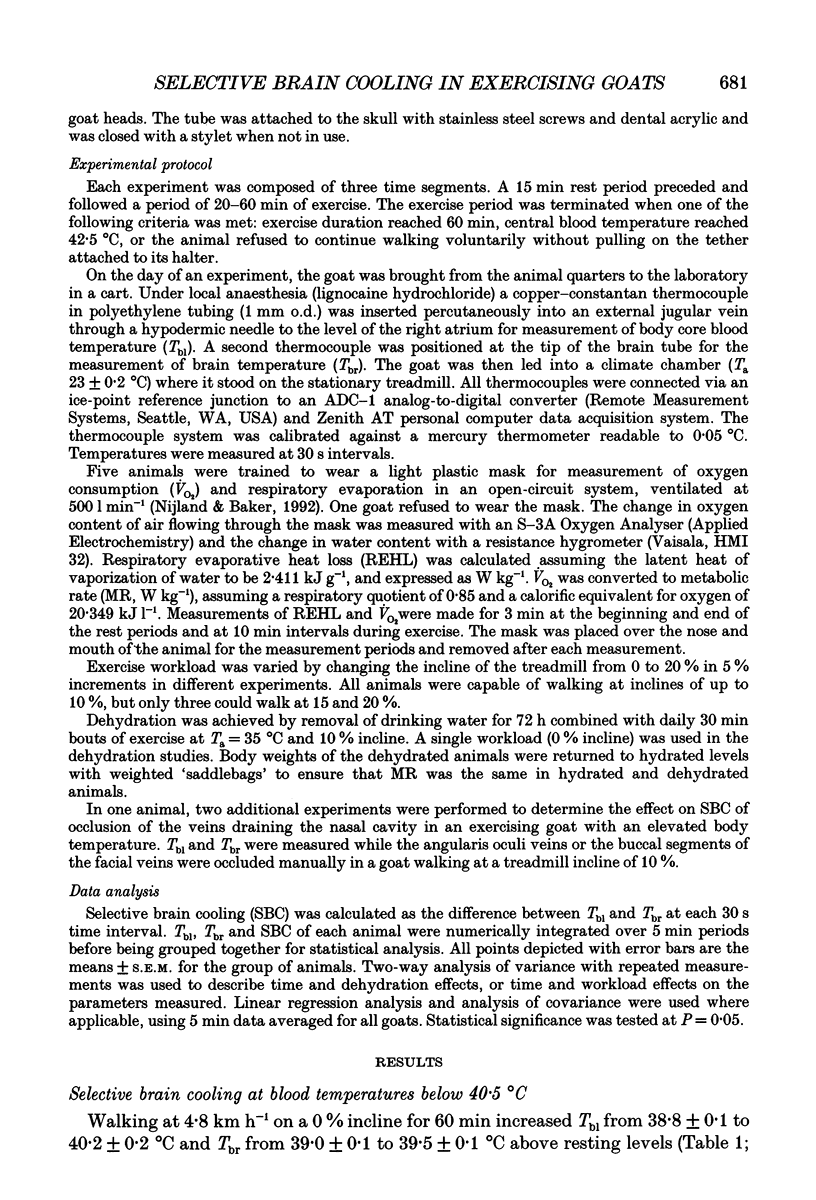


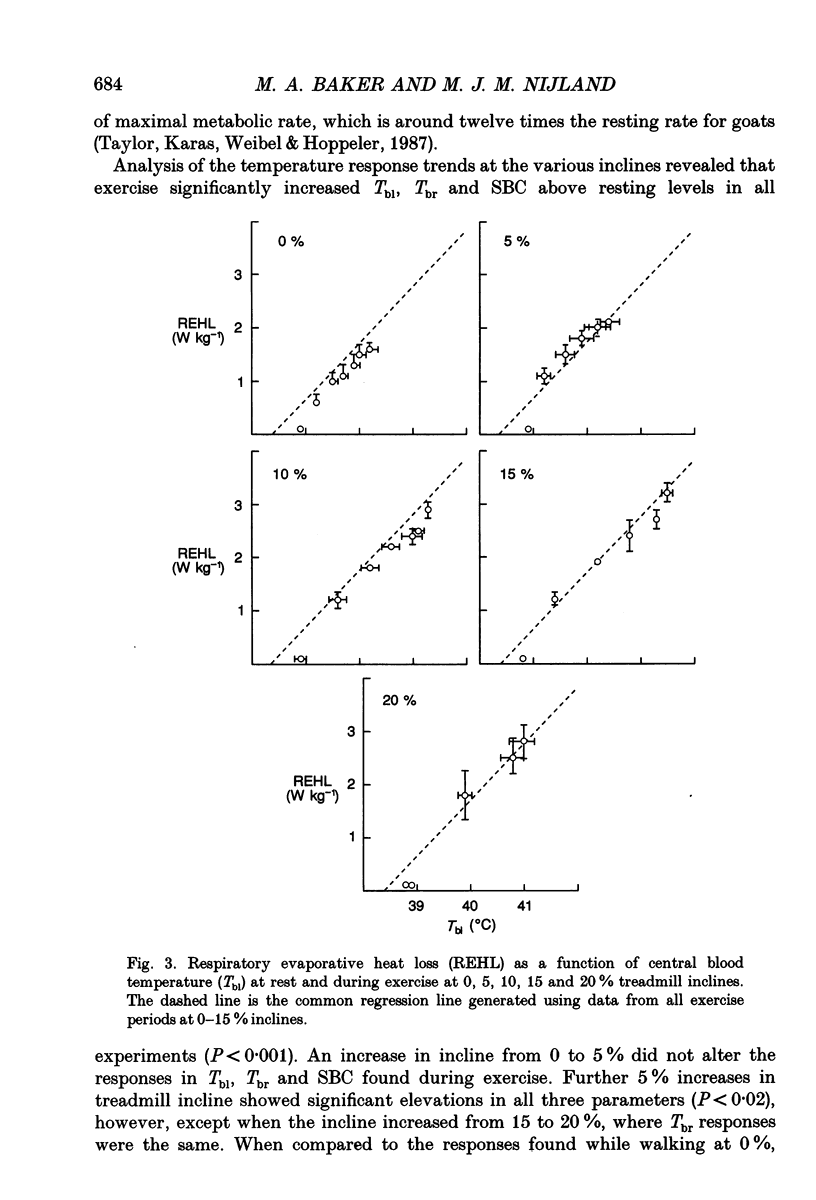

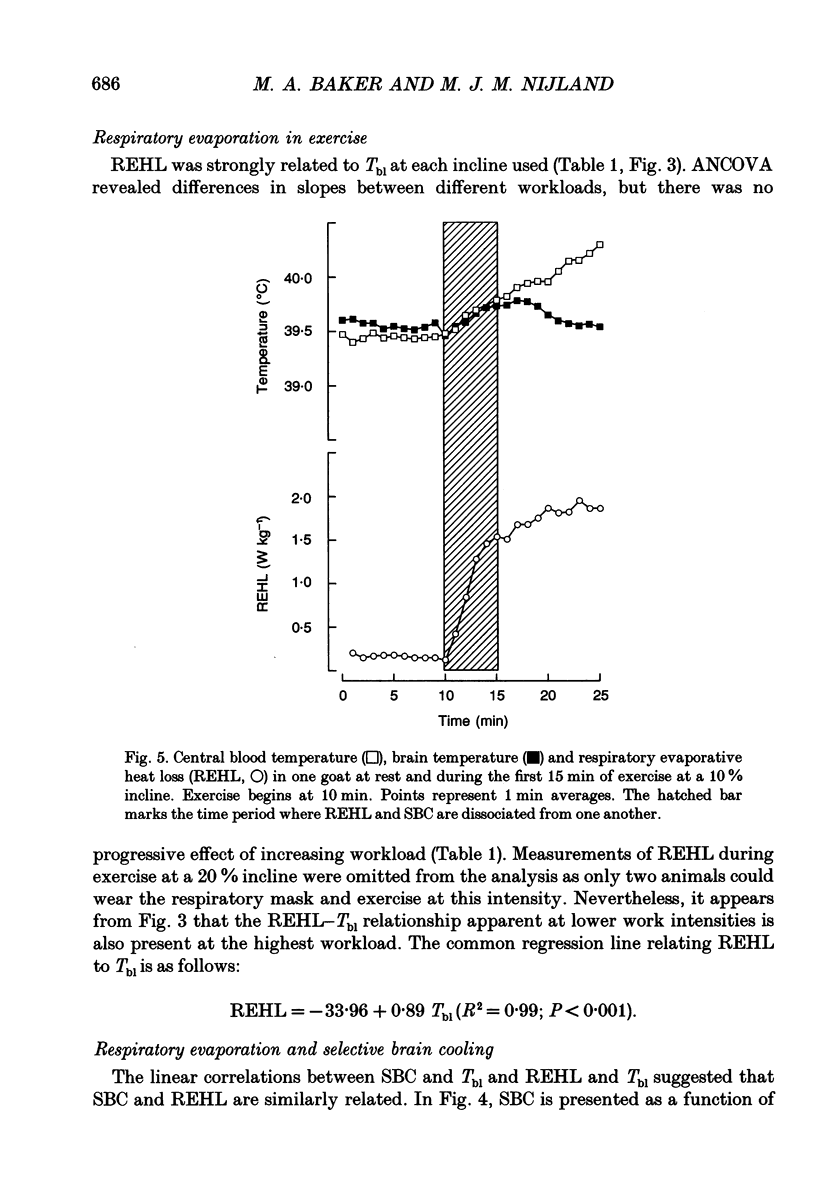
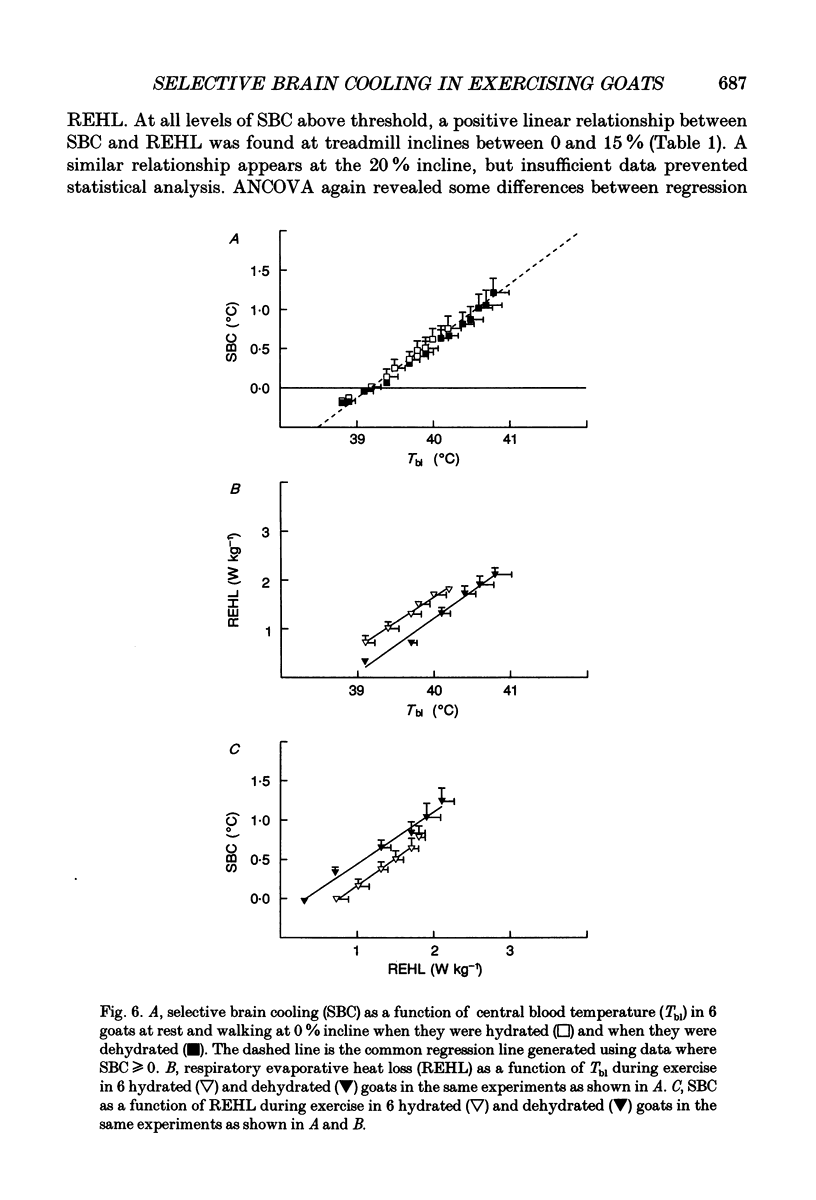
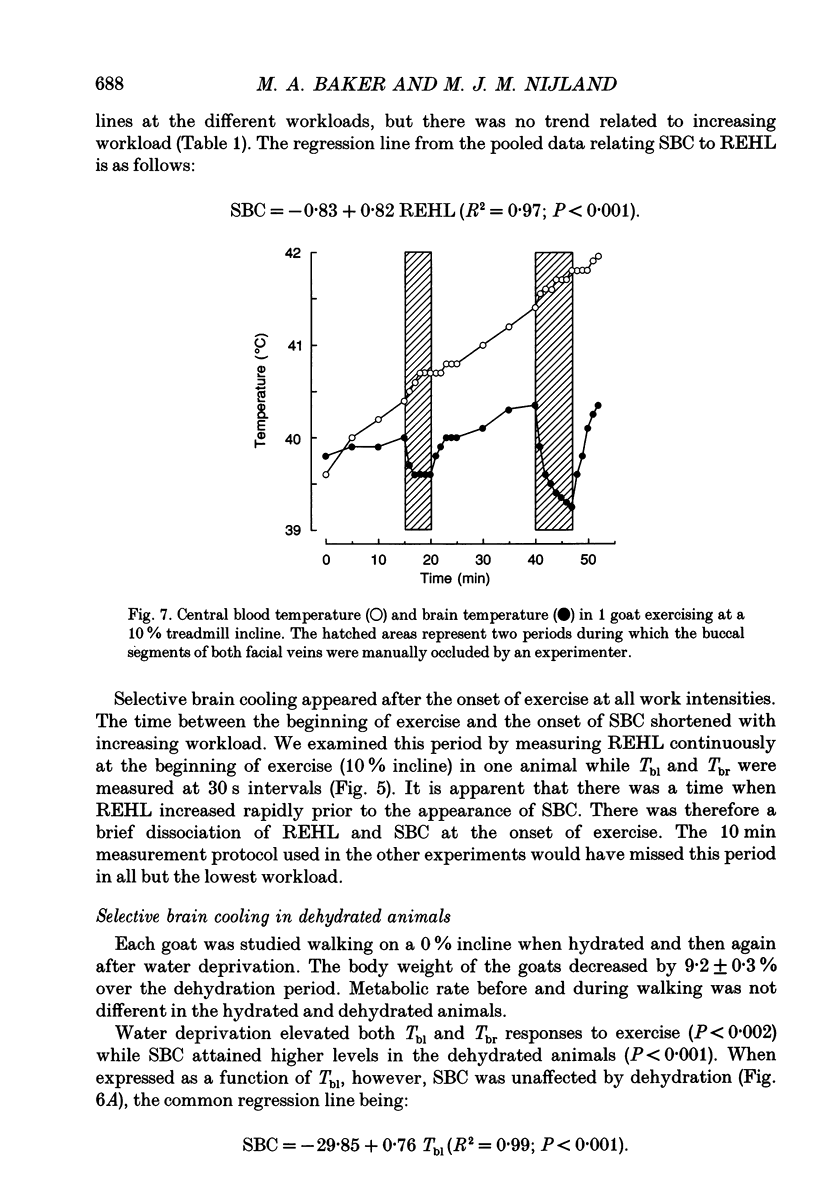
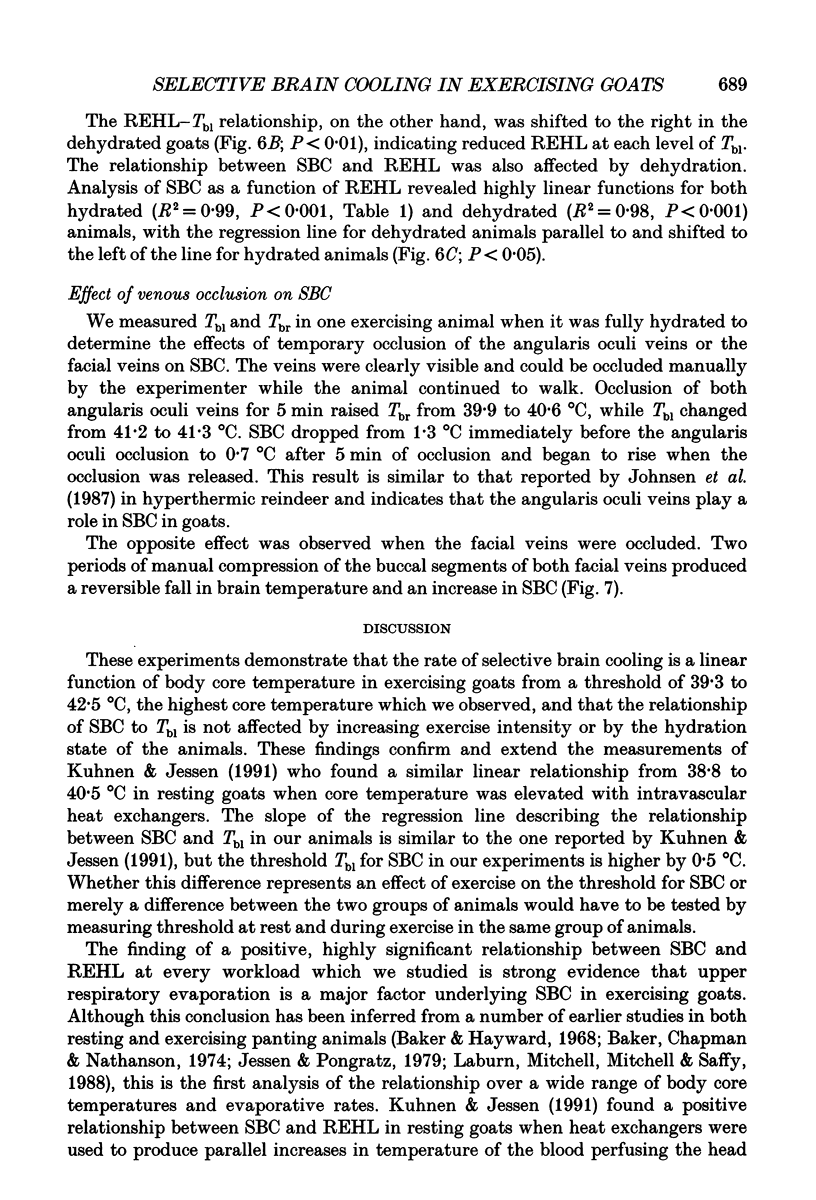
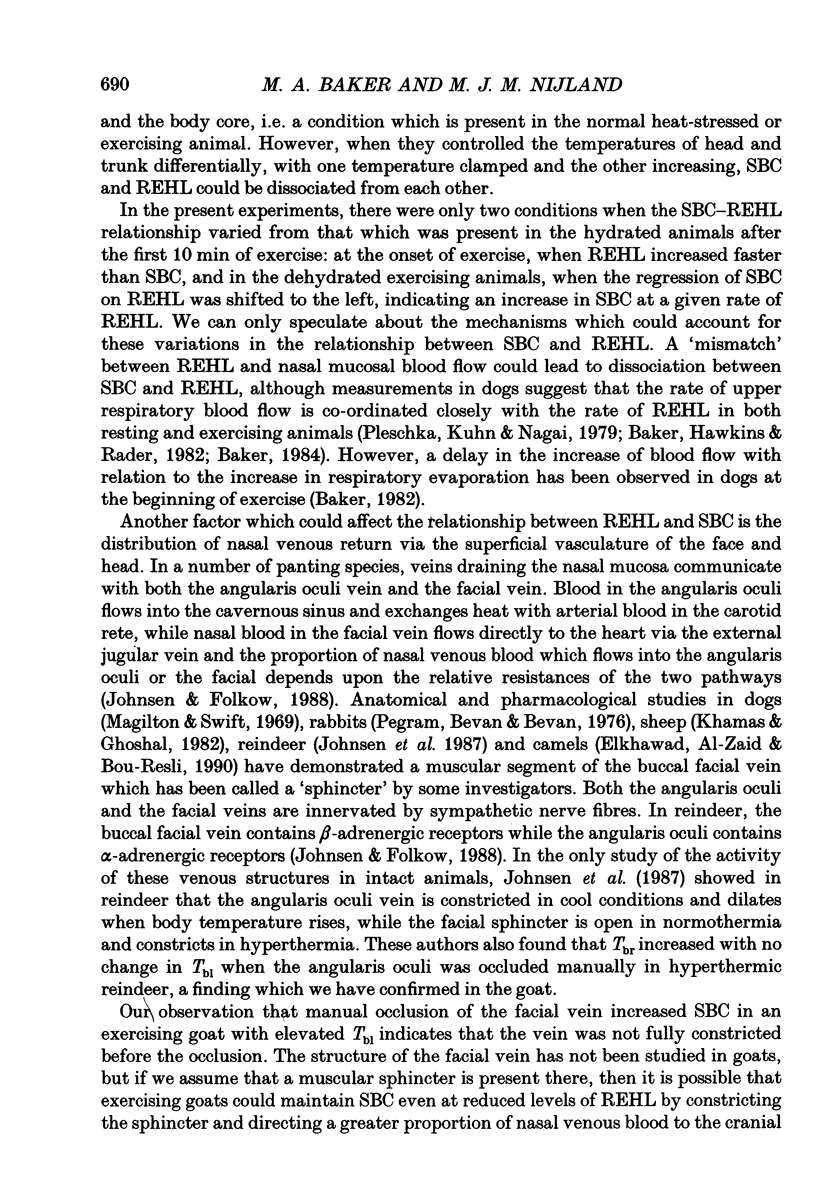
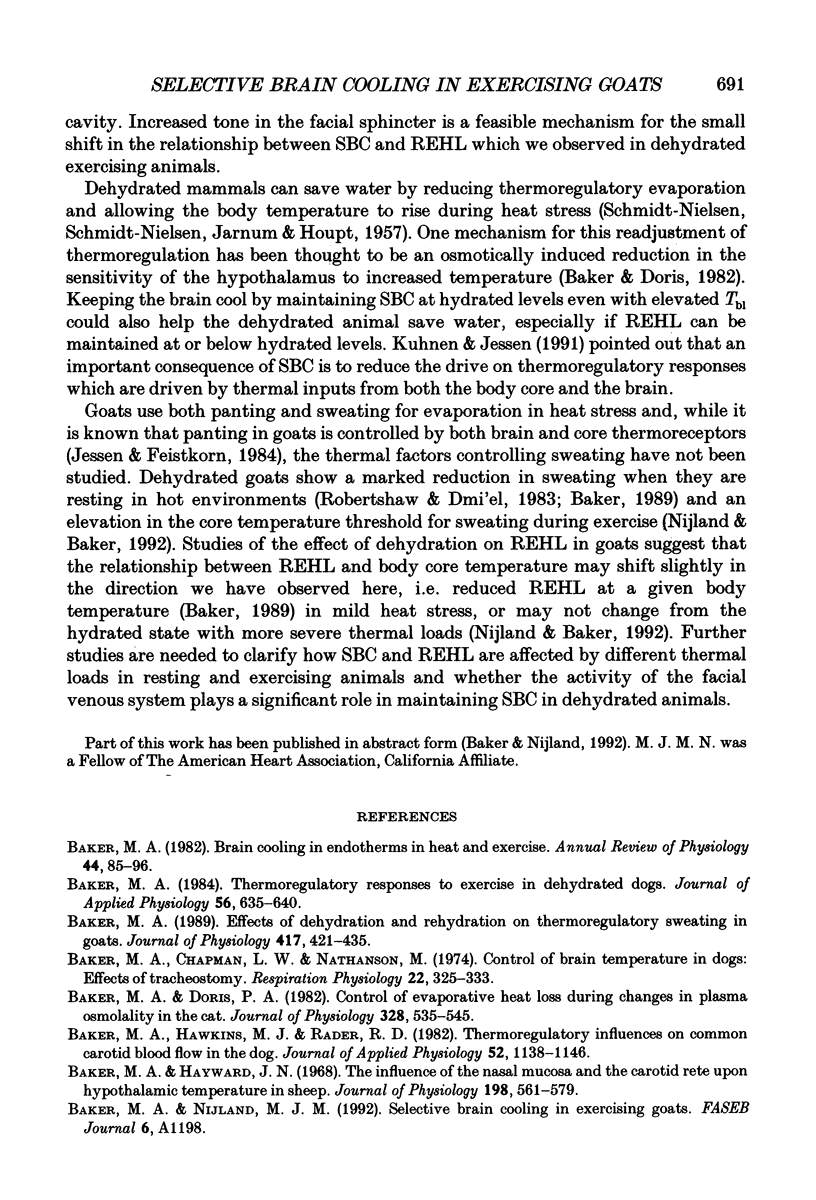
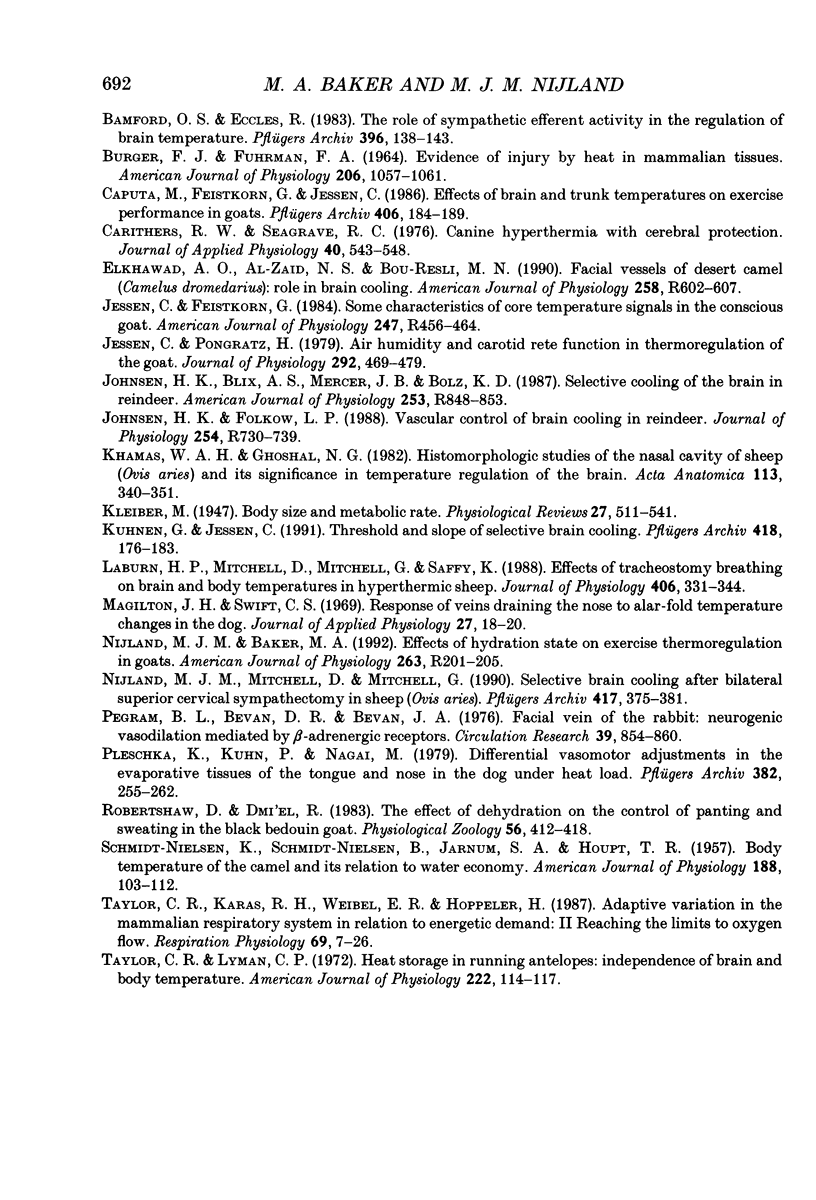
Selected References
These references are in PubMed. This may not be the complete list of references from this article.
- BURGER F. J., FUHRMAN F. A. EVIDENCE OF INJURY BY HEAT IN MAMMALIAN TISSUES. Am J Physiol. 1964 May;206:1057–1061. doi: 10.1152/ajplegacy.1964.206.5.1057. [DOI] [PubMed] [Google Scholar]
- Baker M. A. Brain cooling in endotherms in heat and exercise. Annu Rev Physiol. 1982;44:85–96. doi: 10.1146/annurev.ph.44.030182.000505. [DOI] [PubMed] [Google Scholar]
- Baker M. A., Chapman L. W., Nathanson M. Control of brain temperature in dogs: effects of tracheostomy. Respir Physiol. 1974 Dec;22(3):325–333. doi: 10.1016/0034-5687(74)90081-4. [DOI] [PubMed] [Google Scholar]
- Baker M. A., Doris P. A. Control of evaporative heat loss during changes in plasma osmolality in the cat. J Physiol. 1982 Jul;328:535–545. doi: 10.1113/jphysiol.1982.sp014282. [DOI] [PMC free article] [PubMed] [Google Scholar]
- Baker M. A. Effects of dehydration and rehydration on thermoregulatory sweating in goats. J Physiol. 1989 Oct;417:421–435. doi: 10.1113/jphysiol.1989.sp017810. [DOI] [PMC free article] [PubMed] [Google Scholar]
- Baker M. A., Hawkins M. J., Rader R. D. Thermoregulatory influences on common carotid blood flow in the dog. J Appl Physiol Respir Environ Exerc Physiol. 1982 May;52(5):1138–1146. doi: 10.1152/jappl.1982.52.5.1138. [DOI] [PubMed] [Google Scholar]
- Baker M. A., Hayward J. N. The influence of the nasal mucosa and the carotid rete upon hypothalamic temperature in sheep. J Physiol. 1968 Oct;198(3):561–579. doi: 10.1113/jphysiol.1968.sp008626. [DOI] [PMC free article] [PubMed] [Google Scholar]
- Baker M. A. Thermoregulatory responses to exercise in dehydrated dogs. J Appl Physiol Respir Environ Exerc Physiol. 1984 Mar;56(3):635–640. doi: 10.1152/jappl.1984.56.3.635. [DOI] [PubMed] [Google Scholar]
- Bamford O. S., Eccles R. The role of sympathetic efferent activity in the regulation of brain temperature. Pflugers Arch. 1983 Feb;396(2):138–143. doi: 10.1007/BF00615518. [DOI] [PubMed] [Google Scholar]
- Caputa M., Feistkorn G., Jessen C. Effects of brain and trunk temperatures on exercise performance in goats. Pflugers Arch. 1986 Feb;406(2):184–189. doi: 10.1007/BF00586681. [DOI] [PubMed] [Google Scholar]
- Carithers R. W., Seagrave R. C. Canine hyperthermia with cerebral protection. J Appl Physiol. 1976 Apr;40(4):543–548. doi: 10.1152/jappl.1976.40.4.543. [DOI] [PubMed] [Google Scholar]
- Elkhawad A. O., Al-Zaid N. S., Bou-Resli M. N. Facial vessels of desert camel (Camelus dromedarius): role in brain cooling. Am J Physiol. 1990 Mar;258(3 Pt 2):R602–R607. doi: 10.1152/ajpregu.1990.258.3.R602. [DOI] [PubMed] [Google Scholar]
- Jessen C., Feistkorn G. Some characteristics of core temperature signals in the conscious goat. Am J Physiol. 1984 Sep;247(3 Pt 2):R456–R464. doi: 10.1152/ajpregu.1984.247.3.R456. [DOI] [PubMed] [Google Scholar]
- Jessen C., Pongratz H. Air humidity and carotid rete function in thermoregulation of the goat. J Physiol. 1979 Jul;292:469–479. doi: 10.1113/jphysiol.1979.sp012865. [DOI] [PMC free article] [PubMed] [Google Scholar]
- Johnsen H. K., Blix A. S., Mercer J. B., Bolz K. D. Selective cooling of the brain in reindeer. Am J Physiol. 1987 Dec;253(6 Pt 2):R848–R853. doi: 10.1152/ajpregu.1987.253.6.R848. [DOI] [PubMed] [Google Scholar]
- Johnson H. K., Folkow L. P. Vascular control of brain cooling in reindeer. Am J Physiol. 1988 May;254(5 Pt 2):R730–R739. doi: 10.1152/ajpregu.1988.254.5.R730. [DOI] [PubMed] [Google Scholar]
- Khamas W. A., Ghoshal N. G. Histomorphologic studies of the nasal cavity of sheep (Ovis aries) and its significance in temperature regulation of the brain. Acta Anat (Basel) 1982;113(4):340–351. doi: 10.1159/000145568. [DOI] [PubMed] [Google Scholar]
- Kuhnen G., Jessen C. Threshold and slope of selective brain cooling. Pflugers Arch. 1991 Mar;418(1-2):176–183. doi: 10.1007/BF00370468. [DOI] [PubMed] [Google Scholar]
- Laburn H. P., Mitchell D., Mitchell G., Saffy K. Effects of tracheostomy breathing on brain and body temperatures in hyperthermic sheep. J Physiol. 1988 Dec;406:331–344. doi: 10.1113/jphysiol.1988.sp017383. [DOI] [PMC free article] [PubMed] [Google Scholar]
- Magilton J. H., Swift C. S. Response of veins draining the nose to alar-fold temperature changes in the dog. J Appl Physiol. 1969 Jul;27(1):18–20. doi: 10.1152/jappl.1969.27.1.18. [DOI] [PubMed] [Google Scholar]
- Nijland M. J., Baker M. A. Effects of hydration state on exercise thermoregulation in goats. Am J Physiol. 1992 Jul;263(1 Pt 2):R201–R205. doi: 10.1152/ajpregu.1992.263.1.R201. [DOI] [PubMed] [Google Scholar]
- Nijland M. J., Mitchell D., Mitchell G. Selective brain cooling after bilateral superior cervical sympathectomy in sheep (Ovis aries). Pflugers Arch. 1990 Dec;417(4):375–381. doi: 10.1007/BF00370656. [DOI] [PubMed] [Google Scholar]
- Pegram B. L., Bevan R. D., Bevan J. A. Facial vein in the rabbit. Neurogenic vasodilation mediated by beta-adrenergic receptors. Circ Res. 1976 Dec;39(6):854–860. doi: 10.1161/01.res.39.6.854. [DOI] [PubMed] [Google Scholar]
- Pleschka K., Kühn P., Nagai M. Differential vasomotor adjustments in the evaporative tissues of the tongue and nose in the dog under heat load. Pflugers Arch. 1979 Nov;382(3):255–262. doi: 10.1007/BF00583710. [DOI] [PubMed] [Google Scholar]
- SCHMIDT-NIELSEN K., SCHMIDT-NIELSEN B., JARNUM S. A., HOUPT T. R. Body temperature of the camel and its relation to water economy. Am J Physiol. 1957 Jan;188(1):103–112. doi: 10.1152/ajplegacy.1956.188.1.103. [DOI] [PubMed] [Google Scholar]
- Taylor C. R., Lyman C. P. Heat storage in running antelopes: independence of brain and body temperatures. Am J Physiol. 1972 Jan;222(1):114–117. doi: 10.1152/ajplegacy.1972.222.1.114. [DOI] [PubMed] [Google Scholar]


